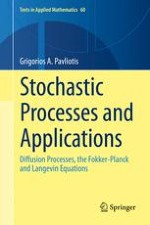2014 | OriginalPaper | Buchkapitel
6. The Langevin Equation
verfasst von : Grigorios A. Pavliotis
Erschienen in: Stochastic Processes and Applications
Verlag: Springer New York
Aktivieren Sie unsere intelligente Suche, um passende Fachinhalte oder Patente zu finden.
Wählen Sie Textabschnitte aus um mit Künstlicher Intelligenz passenden Patente zu finden. powered by
Markieren Sie Textabschnitte, um KI-gestützt weitere passende Inhalte zu finden. powered by
